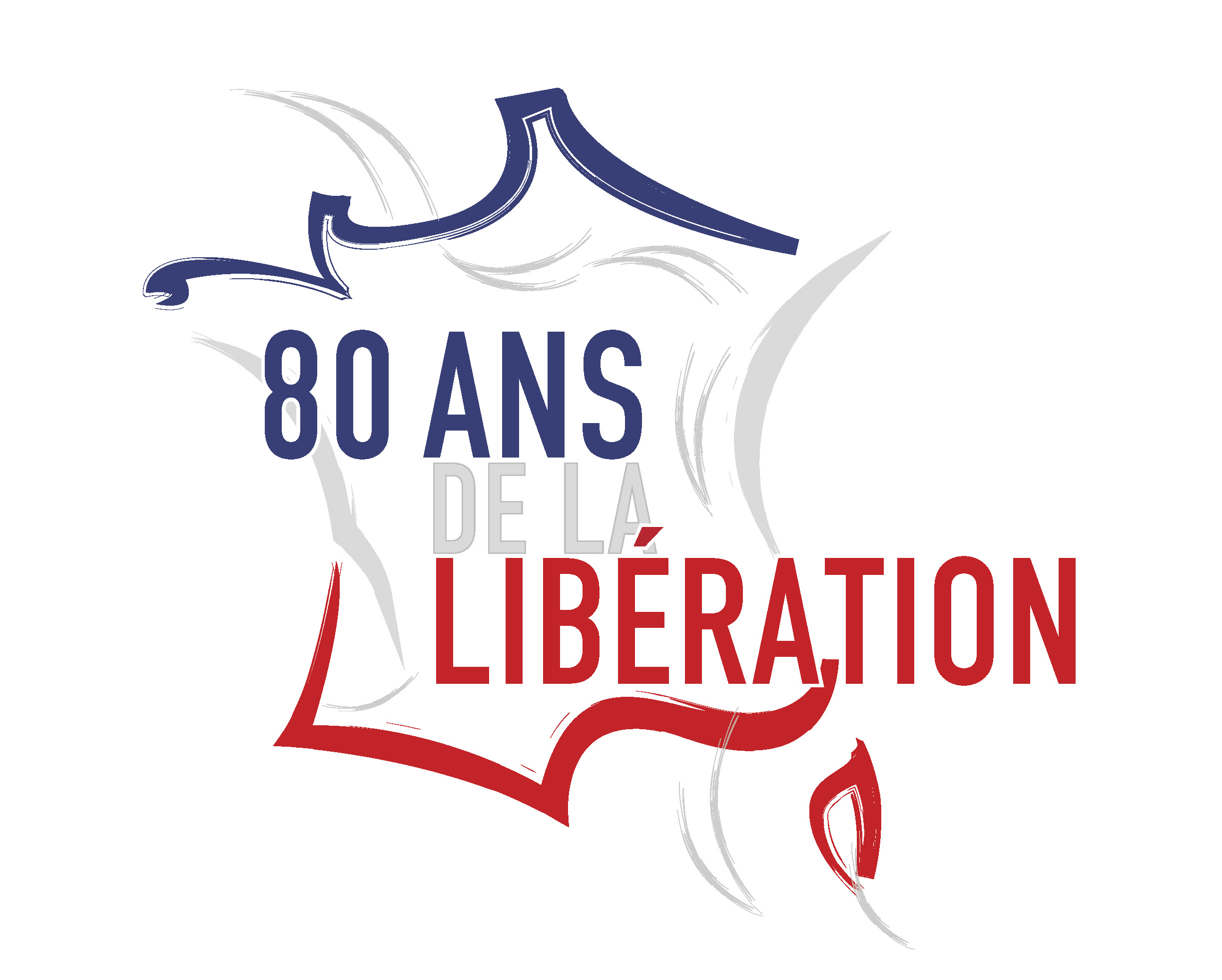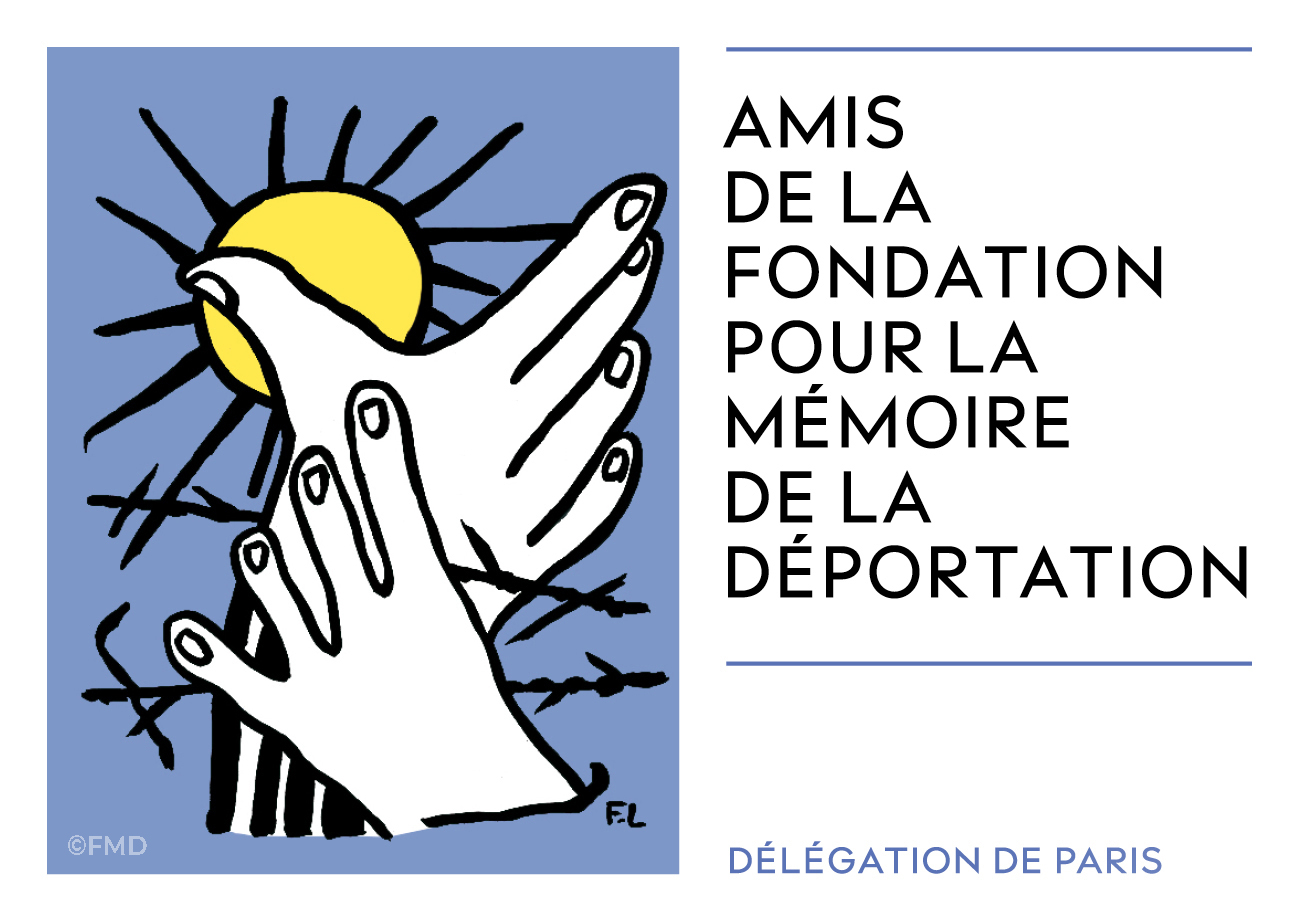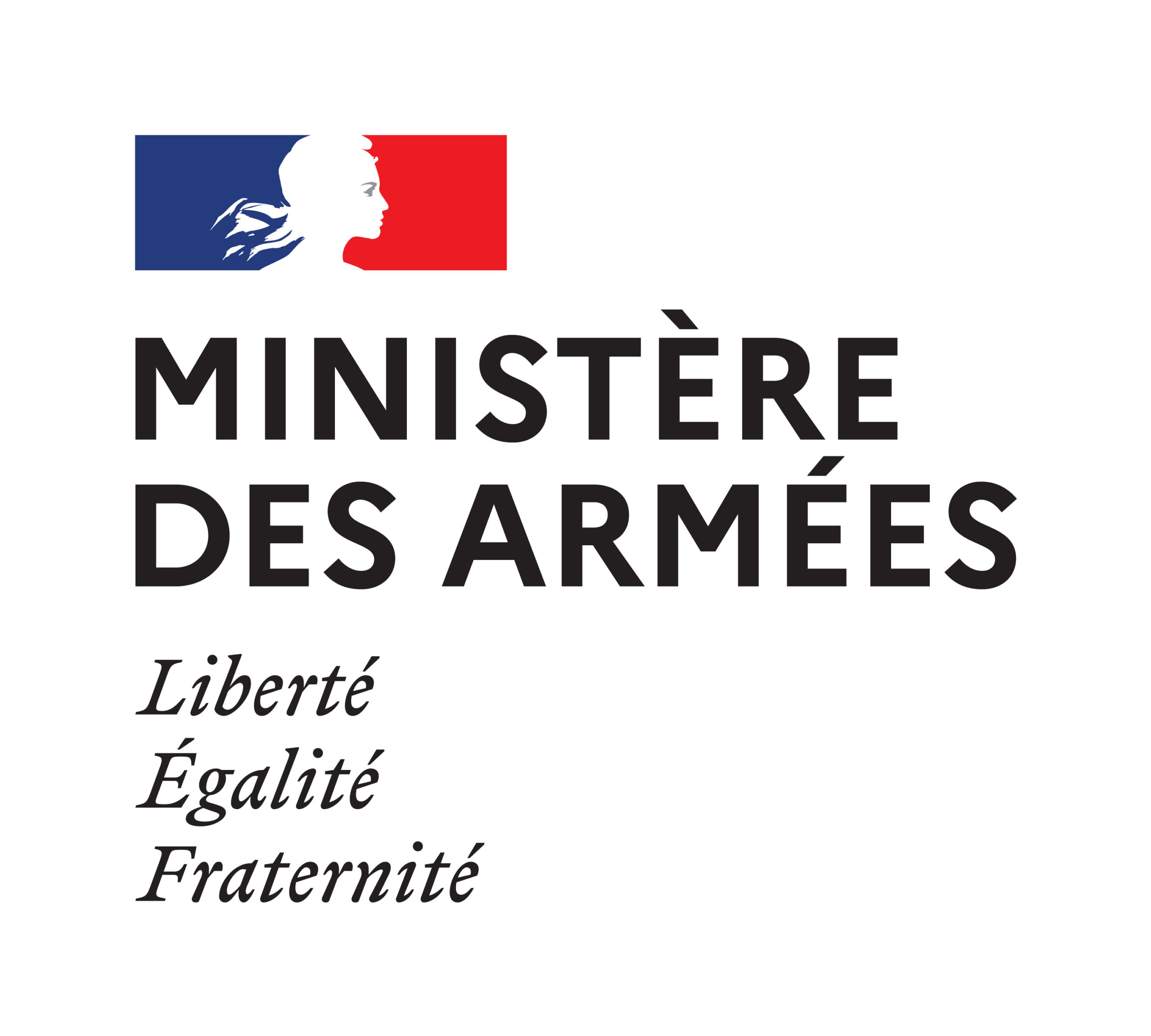THE MONUMENT
TO THE SPANISH
To the Spanish dead for freedom
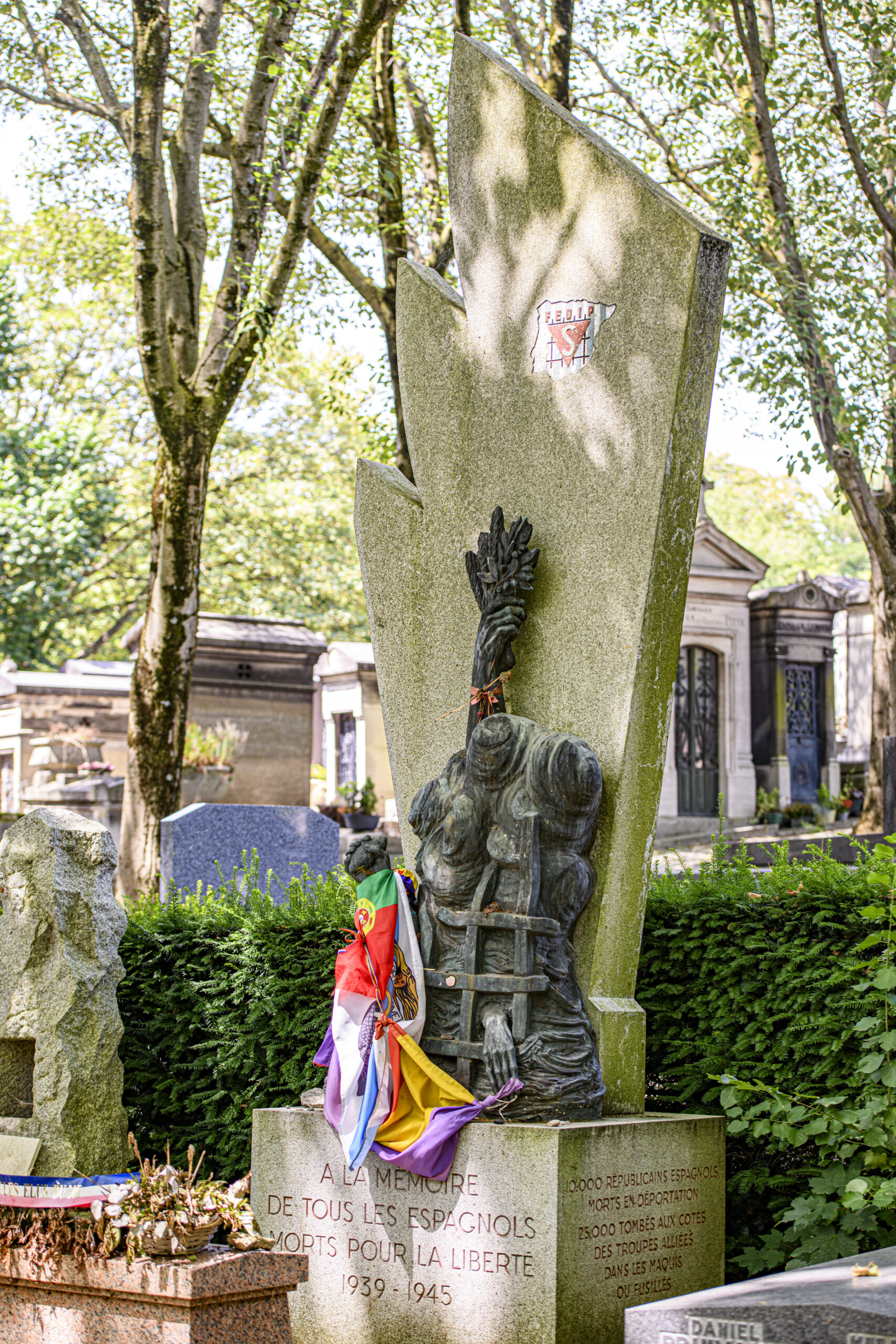
© Vincent Gerbet
Monument description
This monument was inaugurated on April 13, 1969, under the patronage of Professor Charles Richet, a member of the Free France resistance movement, Daniel Mayer, a member of the resistance movement, then president of the Human Rights Committee and Pablo Casals, Catalan cellist, conductor and composer.
Commissioned by the Spanish Federation of Political Deportees and Interned, it is both a tribute to and an appeal for the struggle against fascism and its Spanish expression, Franquism.
The bronze sculpture of I. and J. Gallo stands out in front of a concrete stele in the form of a flame. Tormented silhouettes emerge from a broken cage. One hand that hangs reminds of the death of many deportees, while another firmly holds a fruit that can be interpreted as a pomegranate. A third hand, raised to the sky, brandishes wheat ears and olive branches, symbol of life and peace, but also of Spain, Mediterranean country.
On the top of the stele an S (for Spanier-Spanish) in a red triangle is inscribed on a map of Spain in the colors of the dress of the deportees.
On the front of the pedestal, it is written «In memory of all the Spaniards who died for freedom».
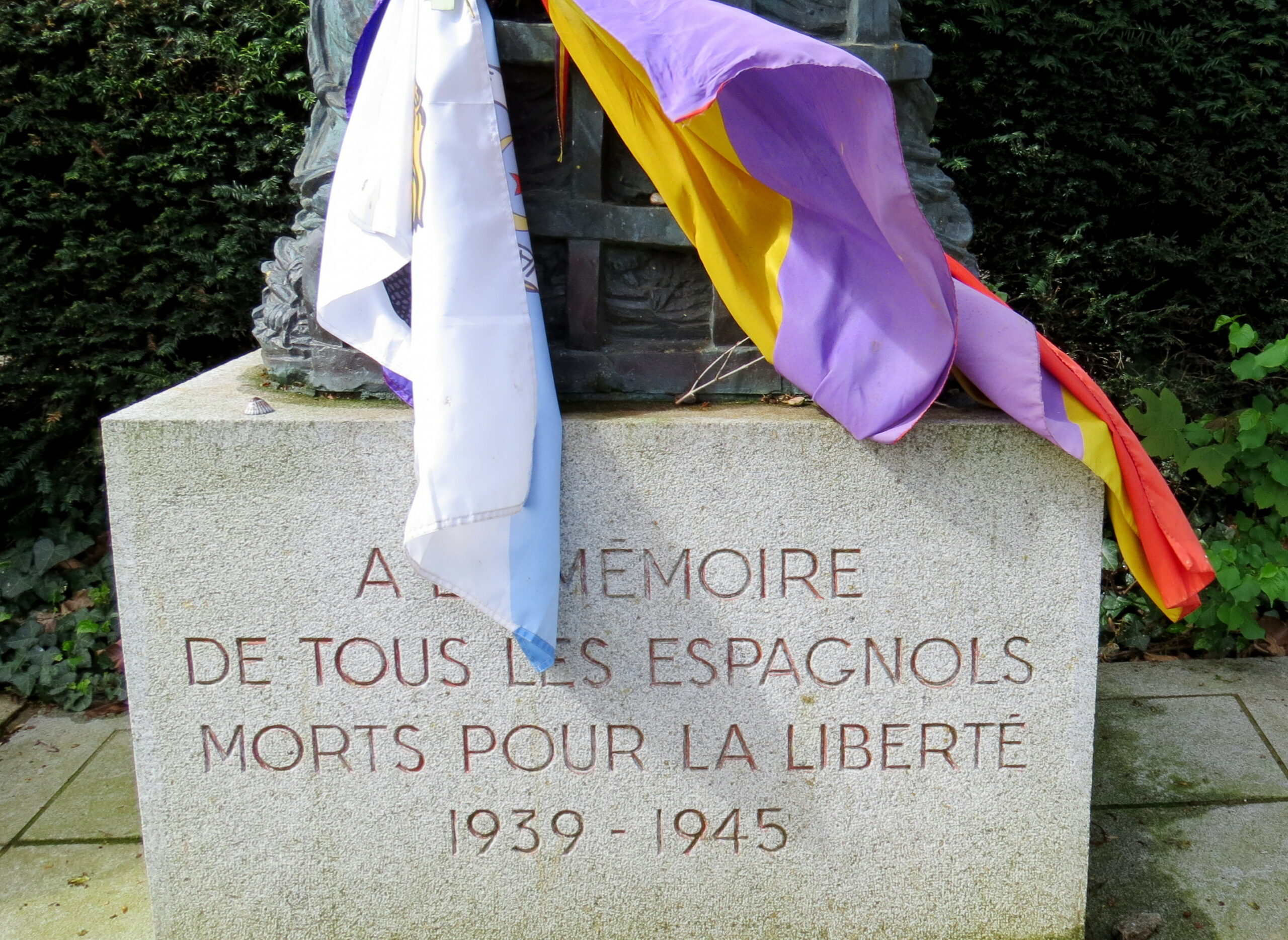
© AFMD 75
On the right side:
« 10,000 Spanish Republicans died in deportation, 25,000 fell alongside the allied troops,
in the maquis or shot. »
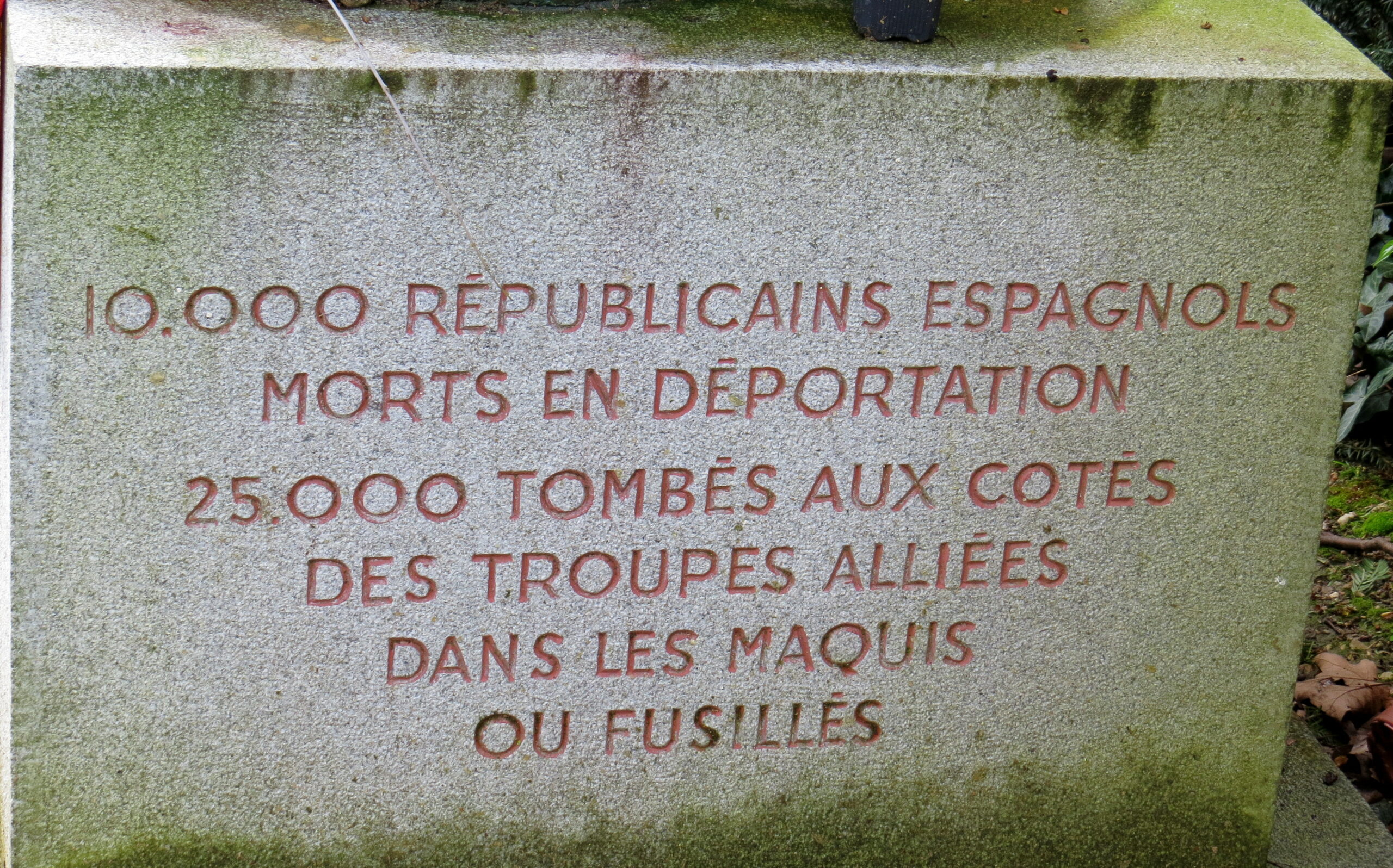
© AFMD 75
On the granite urn is engraved: “This urn contains soil from all the battlefields, as well as from the Nazi concentration camps where thousands of Spanish Republicans died for Freedom.”
Since March 2005, this monument is property of the Spanish state.
Spanish Republicans deported from France
With the non-intervention of democracies, after the victory in 1939 of the nationalist army of General Franco, assisted by the aviation of his German and Italian allies, more than 450,000 men, women and children flee the Spanish civil war to France and cross the border in the Pyrénées-Orientales. This exodus is known as La retirada.
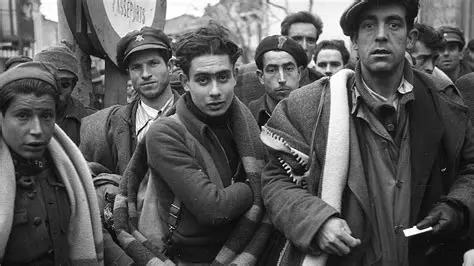
© CDR
The French government of the Third Republic concentrates these refugees in internment camps in the South-West (Argelès, Gurs, Rivesaltes…) hidden behind barbed wire, They are kept by gendarmes, in precarious living conditions.
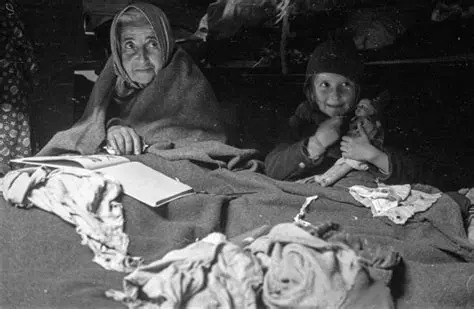
© Mémorial de Rivesaltes
As soon as France declared war on Germany in September 1939, nearly 9,000 men joined the French army.
Many were taken prisoner during the «funny war» ended by the French defeat and the signing of an armistice on 22 June 1940 between the Third Reich, represented by General Wilhelm Keitel, and the last government of the Third Republic, led by Marshal Philippe Pétain and represented by General Charles Huntziger.
The Vichy government, established on 10 July 1940, with full powers given to Marshal Pétain, will deliver the republican men to the German occupier.
Spanish Republicans will be the first to be deported from France
The first deportation convoy from France was sent to the camp at Mauthausen just a month later, on 6 August.
The Nazis consider them as «stateless» because these Spaniards were deprived of their citizenship by the Franco authorities. They are therefore assigned a blue triangle, marked with the letter «S» for «Spanier» (Spanish). Another humiliation for these fighters from 1936.
7 288 Spaniards were deported to Mauthausen and/or the kommandos of this camp like that of Gusen.
4,676 died in it.
From 1943 onwards, other Spaniards who had joined the FTP – M.O.I. (immigrant labour) resistance or the maquis were arrested as opponents or resisters.
They will be deported to the camps of Neuengamme and Auschwitz or for women to Ravensbrück.
They will be assigned the red triangle of politics and the letter “S” (Rot Spanier – Spanish Red).
In total, nearly 12,000 Spaniards were deported to Nazi camps.
70% didn’t survive.
2,000 survivors returned to France, with Franco in power in their native country.
Let us recall that the 9th company of the 2nd DB of Marshal Leclerc, «la Nueve», is the first to enter Paris.
A fresco was inaugurated in the 13th arrondissement of Paris.
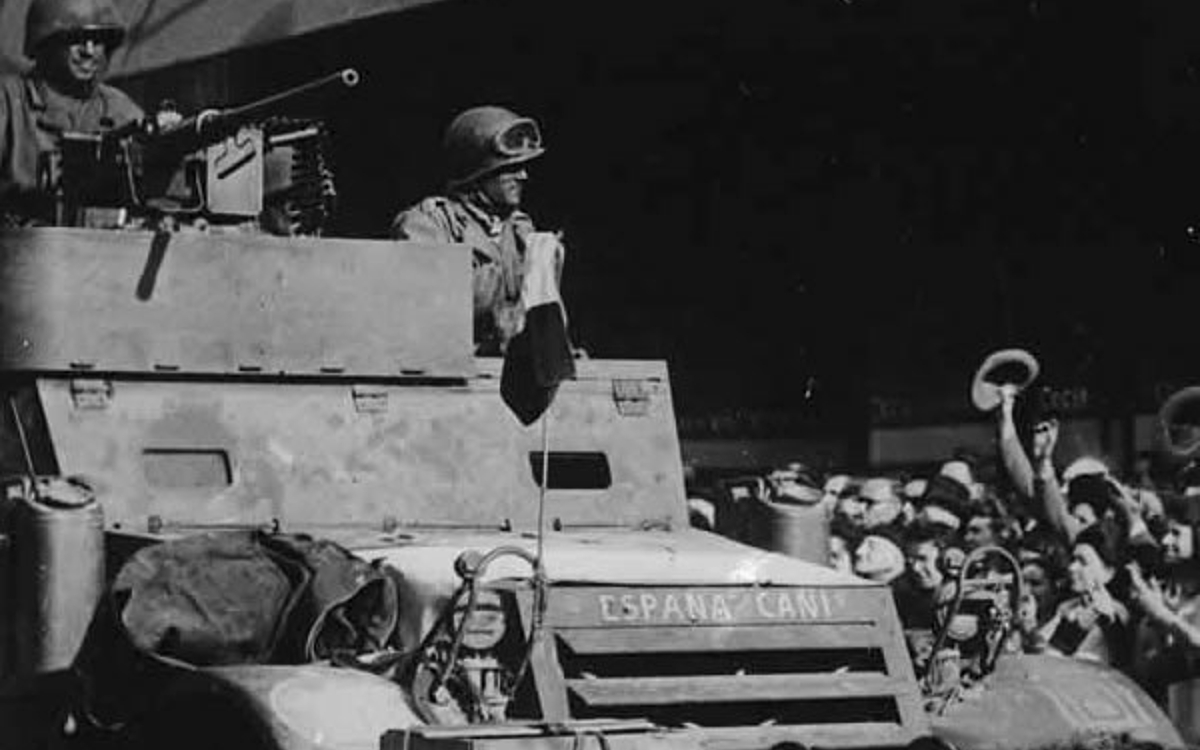
© Mairie de Paris
An example of resistance at the Mauthausen camp
In 1941, the Spanish created a clandestine communist resistance organization. Gradually, it expanded to other political forces and then to other nations to become the International Committee of Resistance.
This committee is behind a secret action by men working in the photographic laboratory of the identification service. Among them a Catalan: Francesc Boix. They stole hundreds of photographs and negatives taken by the Nazis in this camp. They managed to entrust them to a resistance woman from the village of Mauthausen, Anna Pointner, who hid them until the Liberation.
One of the protagonists says:
“We arrived at the home of Anna Pointner, whom we called grandmother, because she had helped us so much…” I explained to her that we needed to save the photos. She told me that she would hide them […] I started to show her the pictures. The lady was very moved when she began to see this series of images of people tortured, hanged, shot, electrocuted. I told him that when the camp was liberated, a comrade would come and get the photos. It was Francesc Boix.”
Francesc Boix took photos himself during the liberation of the camp.
These photos were shown at the Nuremberg and Mauthausen trials.
Francesc Boix testified and confused the Nazi dignitaries.
The photographs were reported and published in France.
Francesc Boix died in Paris in 1951. His grave is located near this monument (division 94).
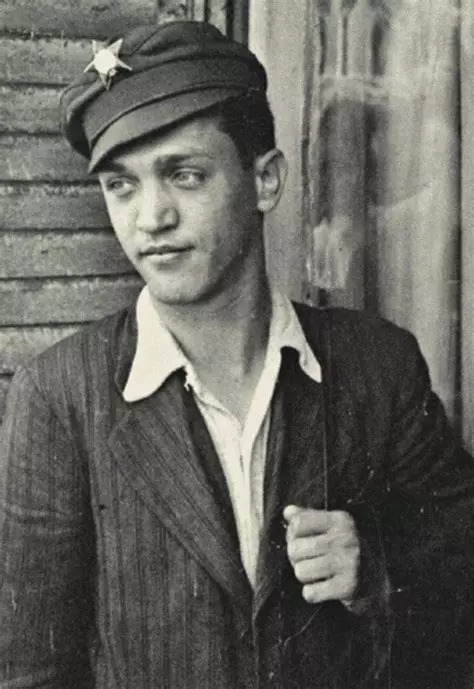
Francesc Boix
© El Mundo.es
Sources
– Amicale de Mauthausen (France): https://campmauthausen.org
– Association of August 24, 1944 – La Nueve: https://www.24-aout-1944.org
– BERMEJO Benito, The photographer of Mauthausen – The story of Francisco Boix and photos stolen from the SS, ed. Territoires de la Mémoire, coll. Ink points, Liège, 2016
– CONSTANTIN Mario and RAZOLA Manuel, Blue Triangle: Spanish Republicans at Mathausen, ed. Le Félin, 2002
– GUERRERO MORENO Rafael, Rotspanier, the Spanish slaves of nazism, documentary film, 2023
– MONTSERRAT Roig, The Catalans in the Nazi Camps, Ed. Triangle bleu, 2005
– OLIVARES Véronique and SALOU Pierre, The Spanish Republicans in the Nazi concentration camp of Mauthausen, preface by Michel REYNAUD, ed Tirésias, 2015
https://www.radiofrance.fr/franceculture/podcasts/pas-la-peine-de-crier/triangle-4-5-l-histoire-des-triangles-bleus-1524110
Monument to the Spanish
To the Spanish dead for freedom

© Vincent Gerbet
Monument description
This monument was inaugurated on April 13, 1969, under the patronage of Professor Charles Richet, a member of the Free France resistance movement, Daniel Mayer, a member of the resistance movement, then president of the Human Rights Committee and Pablo Casals, Catalan cellist, conductor and composer.
Commissioned by the Spanish Federation of Political Deportees and Interned, it is both a tribute to and an appeal for the struggle against fascism and its Spanish expression, Franquism.
The bronze sculpture of I. and J. Gallo stands out in front of a concrete stele in the form of a flame. Tormented silhouettes emerge from a broken cage. One hand that hangs reminds of the death of many deportees, while another firmly holds a fruit that can be interpreted as a pomegranate. A third hand, raised to the sky, brandishes wheat ears and olive branches, symbol of life and peace, but also of Spain, Mediterranean country.
On the top of the stele an S (for Spanier-Spanish) in a red triangle is inscribed on a map of Spain in the colors of the dress of the deportees.
On the front of the pedestal, it is written «In memory of all the Spaniards who died for freedom».

© AFMD 75
On the right side:
« 10,000 Spanish Republicans died in deportation, 25,000 fell alongside the allied troops,
in the maquis or shot. »

© AFMD 75
On the granite urn is engraved: “This urn contains soil from all the battlefields, as well as from the Nazi concentration camps where thousands of Spanish Republicans died for Freedom.”
Since March 2005, this monument is property of the Spanish state.
Spanish Republicans deported from France
With the non-intervention of democracies, after the victory in 1939 of the nationalist army of General Franco, assisted by the aviation of his German and Italian allies, more than 450,000 men, women and children flee the Spanish civil war to France and cross the border in the Pyrénées-Orientales. This exodus is known as La retirada.

© CDR
The French government of the Third Republic concentrates these refugees in internment camps in the South-West (Argelès, Gurs, Rivesaltes…) hidden behind barbed wire, They are kept by gendarmes, in precarious living conditions.

© Mémorial de Rivesaltes
As soon as France declared war on Germany in September 1939, nearly 9,000 men joined the French army.
Many were taken prisoner during the «funny war» ended by the French defeat and the signing of an armistice on 22 June 1940 between the Third Reich, represented by General Wilhelm Keitel, and the last government of the Third Republic, led by Marshal Philippe Pétain and represented by General Charles Huntziger.
The Vichy government, established on 10 July 1940, with full powers given to Marshal Pétain, will deliver the republican men to the German occupier.
Spanish Republicans will be the first to be deported from France
The first deportation convoy from France was sent to the camp at Mauthausen just a month later, on 6 August.
The Nazis consider them as «stateless» because these Spaniards were deprived of their citizenship by the Franco authorities. They are therefore assigned a blue triangle, marked with the letter «S» for «Spanier» (Spanish). Another humiliation for these fighters from 1936.
7 288 Spaniards were deported to Mauthausen and/or the kommandos of this camp like that of Gusen.
4,676 died in it.
From 1943 onwards, other Spaniards who had joined the FTP – M.O.I. (immigrant labour) resistance or the maquis were arrested as opponents or resisters.
They will be deported to the camps of Neuengamme and Auschwitz or for women to Ravensbrück.
They will be assigned the red triangle of politics and the letter “S” (Rot Spanier – Spanish Red).
In total, nearly 12,000 Spaniards were deported to Nazi camps.
70% didn’t survive.
2,000 survivors returned to France, with Franco in power in their native country.
Let us recall that the 9th company of the 2nd DB of Marshal Leclerc, «la Nueve», is the first to enter Paris.
A fresco was inaugurated in the 13th arrondissement of Paris.

© Mairie de Paris
An example of resistance at the Mauthausen camp
In 1941, the Spanish created a clandestine communist resistance organization. Gradually, it expanded to other political forces and then to other nations to become the International Committee of Resistance.
This committee is behind a secret action by men working in the photographic laboratory of the identification service. Among them a Catalan: Francesc Boix. They stole hundreds of photographs and negatives taken by the Nazis in this camp. They managed to entrust them to a resistance woman from the village of Mauthausen, Anna Pointner, who hid them until the Liberation.
One of the protagonists says:
“We arrived at the home of Anna Pointner, whom we called grandmother, because she had helped us so much…” I explained to her that we needed to save the photos. She told me that she would hide them […] I started to show her the pictures. The lady was very moved when she began to see this series of images of people tortured, hanged, shot, electrocuted. I told him that when the camp was liberated, a comrade would come and get the photos. It was Francesc Boix.”
Francesc Boix took photos himself during the liberation of the camp.
These photos were shown at the Nuremberg and Mauthausen trials.
Francesc Boix testified and confused the Nazi dignitaries.
The photographs were reported and published in France.
Francesc Boix died in Paris in 1951. His grave is located near this monument (division 94).

Francesc Boix
© El Mundo.es
Sources
– Amicale de Mauthausen (France): https://campmauthausen.org
– Association of August 24, 1944 – La Nueve: https://www.24-aout-1944.org
– BERMEJO Benito, The photographer of Mauthausen – The story of Francisco Boix and photos stolen from the SS, ed. Territoires de la Mémoire, coll. Ink points, Liège, 2016
– CONSTANTIN Mario and RAZOLA Manuel, Blue Triangle: Spanish Republicans at Mathausen, ed. Le Félin, 2002
– GUERRERO MORENO Rafael, Rotspanier, the Spanish slaves of nazism, documentary film, 2023
– MONTSERRAT Roig, The Catalans in the Nazi Camps, Ed. Triangle bleu, 2005
– OLIVARES Véronique and SALOU Pierre, The Spanish Republicans in the Nazi concentration camp of Mauthausen, preface by Michel REYNAUD, ed Tirésias, 2015
https://www.radiofrance.fr/franceculture/podcasts/pas-la-peine-de-crier/triangle-4-5-l-histoire-des-triangles-bleus-1524110
Délégation de Paris des Amis de la Fondation
pour la Mémoire de la Déportation
31 Boulevard Saint-Germain 75005 Paris
Contact : afmd.dt75@gmail.com
©AFMD75

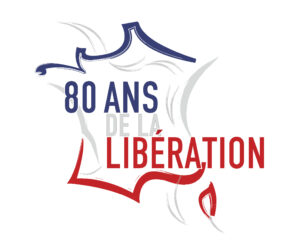
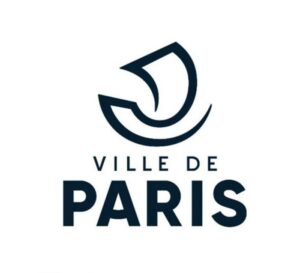
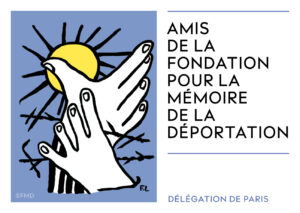
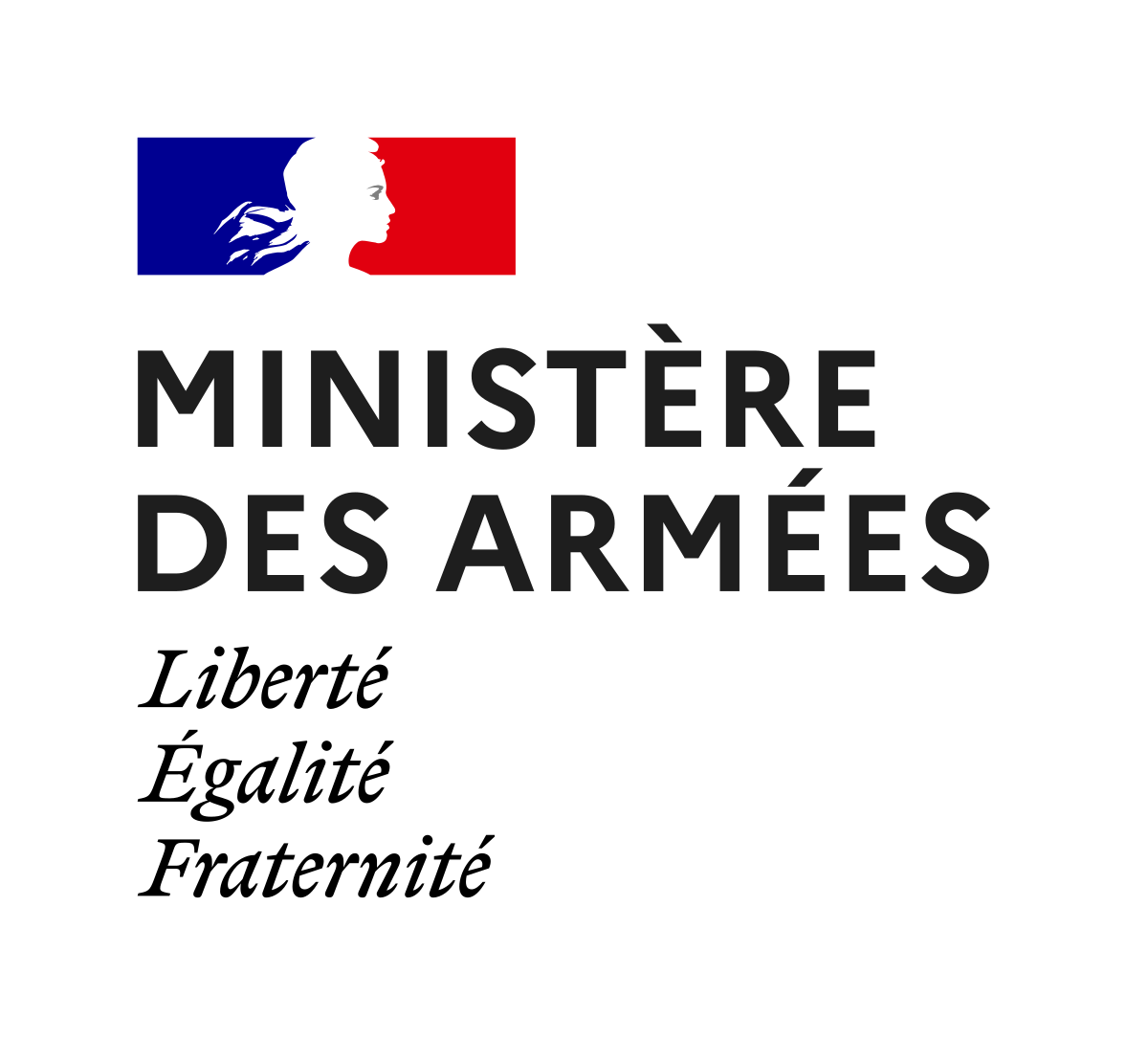
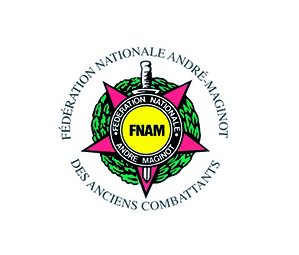
Délégation de Paris
des Amis de la Fondation
pour la Mémoire de la Déportation
31 Boulevard Saint-Germain
75005 Paris
Contact :
afmd75@gmail.com
©AFMD75
Délégation de Paris
des Amis de la Fondation
pour la Mémoire
de la Déportation
31 Boulevard Saint-Germain
75005 Paris
Contact
afmd75@gmail.com
©AFMD75

